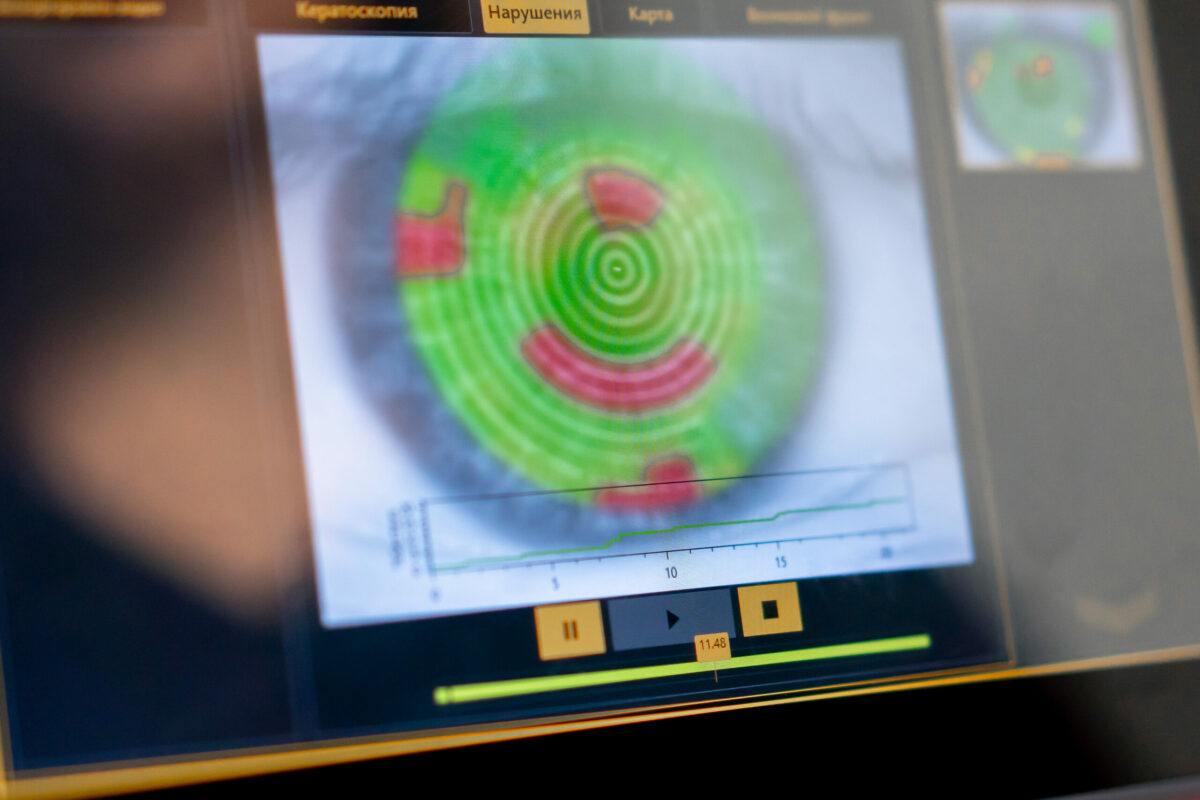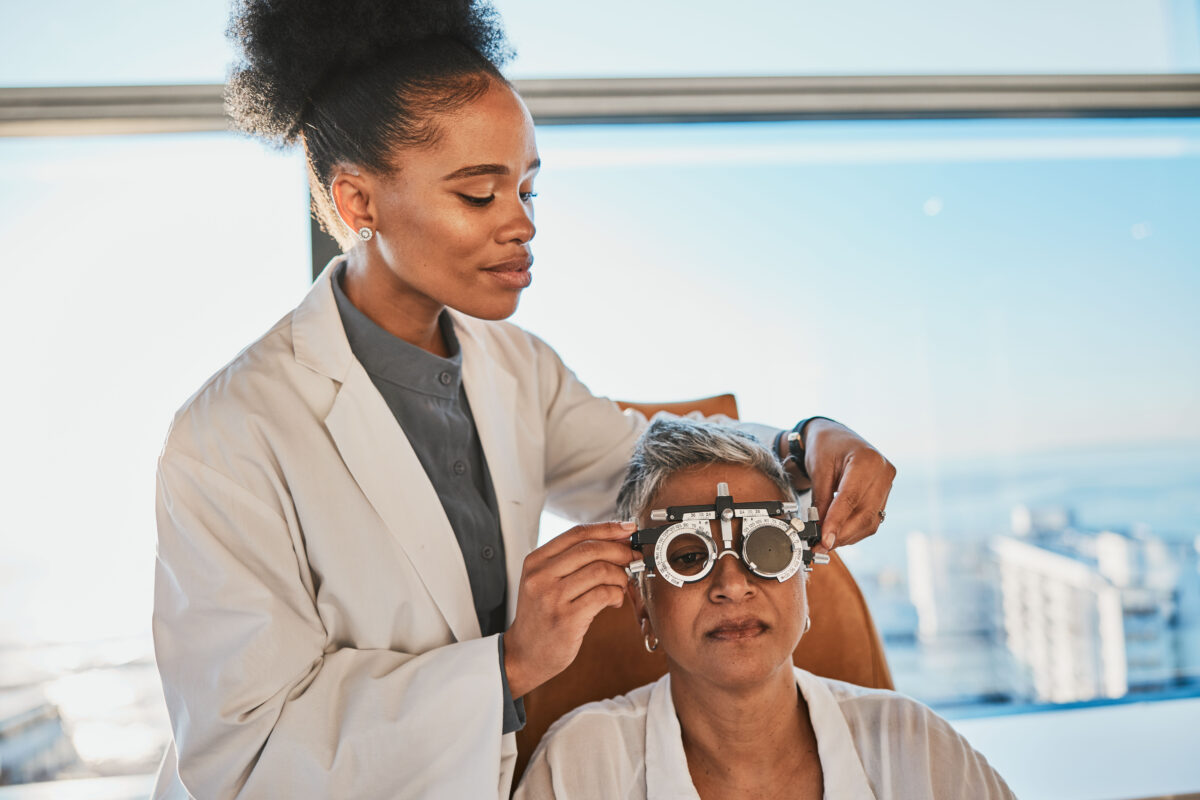An eye condition in which damage to the optic nerve occurs is called glaucoma. Thus, damage to the optic nerve may lead to partial or complete vision loss (blindness). In normal circumstances, this nerve sends visual information from the eye to the brain and it is essential for good vision. In most cases, damage to the optic nerve happens due to increased pressure inside the eye. However, this eye disease may occur even with normal eye pressure.
Although this condition may occur at any age, it most commonly happens in older adults and it is one of the leading causes of complete vision loss in people older than 60 years.
There are multiple glaucoma types that do not cause any symptoms and vision loss is so gradual until it is usually found in later stages. That’s why it is very important to have regular eye examinations that include eye pressure measurements. Identifying this eye condition early may help prevent vision loss or it can be slowed. In any case, if you are diagnosed with glaucoma, you will need monitoring and treatment lifelong.
Symptoms
The symptoms of this eye disease appear depending on the type you experience. Examples include:
Open-angle Glaucoma
- In the early stages no symptoms
- Patchy blind spots in the side vision (also known as peripheral vision)
- Central vision problems (in later stages usually occur)
Acute Angle-closure Glaucoma
- Severe eye pain
- Headaches
- Nausea
- Vomiting
- Blurred vision
- Halos or colored rings around lights
- Eye redness
Normal-tension Glaucoma
- Without symptoms in the early stages
- Blurred vision that occurs gradually
- Loss of peripheral vision (in severe cases may happen)
Glaucoma in Children
- A cloudy or dull eye increased blinking, tears without crying (infants)
- Blurred vision
- Headaches
- Nearsightedness that may get worse
Pigmentary Glaucoma
- Halos around lights
- Blurred vision that occurs when you exercise
- Loss of side vision that happens gradually
If you experience bad headaches and severe eye pain, immediately contact an ophthalmologist or go to the nearest emergency room.
Causes
This condition appears usually due to damage to the optic nerve. Moreover, people may notice blind spots that develop in their vision often when the optic nerve gets worse. However, experts do not fully understand the causes. That’s why damage to the optic nerve is related to elevated pressure inside the eye in most cases.
Increased pressure inside the eye often happens due to fluid buildup. In normal cases, the fluid (aqueous humor) that flows inside the eye drains through a tissue (trabecular meshwork) located where the cornea meets the iris. The cornea is an important part of the eye that allows light to enter the eye. Therefore, when the eye produces too much aqueous humor or the drainage system does not work normally, it may lead to elevated pressure inside the eye.
Open-angle Glaucoma
It occurs when the drainage angle remains open and other drainage parts do not work as they should. Therefore, it causes a gradual increase in eye pressure. Additionally, this is the most common glaucoma type.
Acute Angle-closure Glaucoma
This glaucoma type usually occurs when the iris becomes swollen. When it happens, the bulging iris blocks either partially or completely the drainage angle. Hence, the fluid cannot circulate through the eye leading to increased pressure. This form of glaucoma may happen suddenly or gradually.
Normal-tension Glaucoma
Unfortunately, no one knows the exact cause of this glaucoma type. Some healthcare providers think it occurs because the optic nerve is sensitive or experiences less blood flow. Reduced blood flow may happen due to deposits in the arteries (also known as atherosclerosis) that supply the optic nerve with blood.
Glaucoma in Children
Damage to the optic nerve in children usually happens due to blocked drainage, injury, or an underlying health condition. Moreover, glaucoma occurs in children either at birth (congenital) or develop in the first several years of life.
Pigmentary Glaucoma
It happens when small pigment granules flake away from the iris and block the drainage system of the eye. In most cases, activities such as jogging stir up the pigment granules.
In addition, this condition tends to run in families according to some scientists that found abnormal genes related to increased pressure in the eye and damage to the optic nerve.
Risk Factors
Vision damage due to glaucoma may occur before you will begin to notice symptoms. Check below some glaucoma risk factors:
- Family history of glaucoma
- Thin center of cornea
- Extreme nearsightedness or farsightedness
- Eye injuries
- Certain medicines (such as corticosteroid eye drops used for long periods)
- Asian, Black, or Hispanic heritage
- People over 60 years old
- High pressure inside the eye (intraocular pressure)
- Some health conditions (including diabetes, migraine, hypertension, sickle cell anemia, and others)
Sometimes, people have an increased risk of angle-closure glaucoma due to narrowed drainage angles.
How to Prevent Glaucoma?
Considering the following steps, you may reduce the risk of glaucoma and prevent vision loss. Examples include:
- Regular eye examinations – The American Academy of Ophthalmology recommends eye examinations every 5 to 10 years if you are under 40 years old. If you are over this age, you should have eye examinations every 1-2 years. However, if you are at risk of glaucoma, you will need examinations more frequently.
- Family history of glaucoma – This condition tends to run in families, which also makes you need screening more often.
- Eye protection – It is advised to wear eye protection, especially when using power tools or playing sports because damage to the eye may lead to glaucoma.
- Medicines – Specific eye drops may reduce the risk of high pressure inside the eye that may cause glaucoma. Use medications exactly as prescribed by your healthcare professional even if you do not experience any symptoms.
Diagnosis
Physicians to diagnose this condition will review your medical history and perform an eye examination. Check below tests involved during the eye examination:
- Optic nerve damage tests using imaging tests
- Tonometry (measurement of the intraocular pressure)
- A visual field test (it is used to check the vision loss areas)
- Pachymetry (this test helps doctors measure the thickness of the cornea)
- Gonioscopy (inspection of the drainage angle)
Treatment
Unfortunately, damage caused by this eye disease cannot be reversed but treatment and regular eye examinations may slow down vision loss, especially if the condition is detected in the early stage.
The treatment goal is to reduce pressure inside the eye. Healthcare professionals usually prescribe eye drops, oral medications, laser treatment, surgery, and others.
Eye Drops
Commonly, glaucoma treatment begins with eye drops that help reduce intraocular pressure by improving fluid drainage. Other medicines help reduce fluid production by the eye. Sometimes, physicians prescribe more eye drops. Check below the most common medicines recommended by doctors for people with glaucoma:
- Prostaglandins – These medicines help improve fluid drainage from the eye, which helps reduce intraocular pressure. These include Latanoprost, Travoprost, Tafluprost, Bimatoprost, and Latanoprostene bunod. Possible adverse reactions include redness and stinging of the eyes, iris darkening, and blurred vision.
- Beta-blockers – These medications reduce fluid production in the eye. For example Betaxolol and Timolol. Breathing problems, reduced heart rate, hypotension, impotence (erectile dysfunction), and extreme tiredness (fatigue) are possible negative effects.
- Alpha-adrenergic agonists – This group of medications also reduces fluid production and improves the outflow of fluid in the eye. For example Apraclonidine and Brimonidine. Those who use these medicines may experience the following side effects including dry mouth, hypertension (high blood pressure), irregular heart rate, swollen eyes, and others.
- Carbonic anhydrase inhibitors – These medications also are used to reduce fluid production in the eye. These include Dorzolamide and Brinzolamide. Frequent urination, a metallic taste in the mouth, and tingling in the toes and fingers are potential side effects.
- Rho kinase inhibitor – This medication helps reduce intraocular pressure by inhibiting enzymes responsible for fluid increase. Doctors often prescribe Netarsudil.
- Miotic or cholinergic agents – These medications are used to improve fluid drainage from the eye. Physicians commonly recommend Pilocarpine. Common negative effects include dim or blurred vision, eye pain, headaches, and nearsightedness.
Oral Medications
Sometimes, to reduce intraocular pressure within normal ranges, physicians may prescribe oral medications (such as a carbonic anhydrase inhibitor). Common adverse reactions include tingling in the fingers and toes, depression, stomach upset, kidney stones, and frequent urination.
Other Treatments
The following procedures are used to reduce pressure inside the eye. For example:
- Laser therapy – It is also called laser trabeculoplasty and is used if medicines do not work. Moreover, physicians may recommend laser surgery before using eye drops to improve drainage of the fluid from the eye.
- Filtering surgery – This surgery is also known as a trabeculectomy. During the procedure, ophthalmologists will make an opening in the white of the eye (sclera) that helps extra fluid leave the eye.
- Drainage tubes – This procedure involves small tubes that are inserted into the eye to drain extra fluid and reduce intraocular pressure.
- Minimally invasive glaucoma surgery (MIGS) – This procedure is usually recommended by doctors when other treatment options are not effective and require immediate postoperative care but have less risk than a drainage device or trabeculectomy. Commonly, MIGS is combined with cataract surgery.
Home Remedies
There are some tips that may help promote eye health and control high intraocular pressure. Examples include:
- Adopt a healthy diet that includes vitamins and nutrients that are important to eye health. These include Selenium, Copper, Zinc, and antioxidant vitamins such as C, E, and A.
- Exercise safely using eye protection (such as glasses).
- Avoid large amounts of caffeine because it may increase your intraocular pressure.
- Drinking large amounts of liquids in a short period may temporarily increase pressure inside the eye.
- Administer prescription medications exactly as prescribed by your healthcare professional.
Frequently Asked Questions
Is it possible to cure glaucoma?
Unfortunately, there is no way to cure glaucoma but with proper treatment, you can reduce the symptoms and prevent complications (such as blindness).
What are the possible complications of glaucoma?
If you are not treating glaucoma, it may lead to some serious complications. These include:
- Loss of visual field
- Reduced visual acuity
- Blindness
- Damage to the corneal endothelium, which may lead to corneal decompensation
- Aqueous misdirection syndrome
If you suspect you have any of the previous complications, immediately contact an ophthalmologist.
What health problems may be caused by glaucoma?
As per studies, glaucoma may cause other health conditions including hypertension (high blood pressure), sleep apnea, cardiovascular disease, diabetes, and others. Ask your doctor if you have any other questions.




